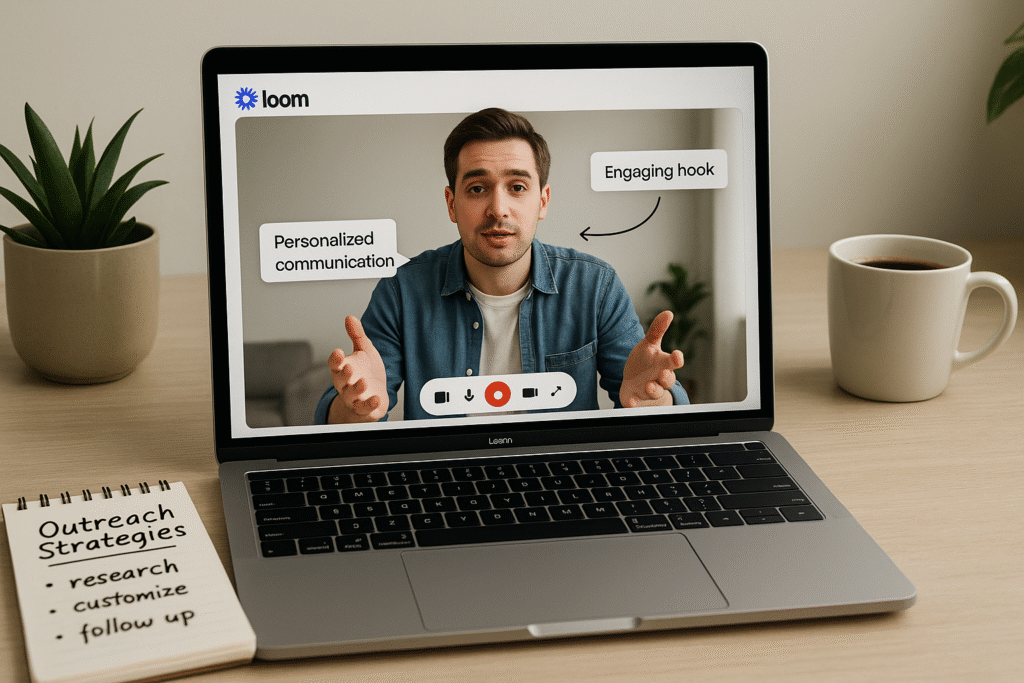Introduction to Loom Outreach: The Hidden Goldmine
Loom video outreach has become a transformative tool for client engagement, categorized as one of the highest converting methods in outreach efforts. However, despite its potential, many users fail to utilize it effectively, often causing their messages to resemble spam rather than a tailored communication. To avoid this, it’s essential to follow a structured approach that enhances personalization and engagement.
The Blueprint for Effective Loom Videos
The effectiveness of Loom outreach hinges on how the videos are crafted. The first step is to ensure you start on the client’s page or relevant resource, meaning the video frame displays their profile immediately. This not only sets a relevant context but visually signals to the recipient that the message is personalized rather than templated. The beginning of the video is critical; ideally, within the first 15 to 30 seconds, you should emphasize the value you’re providing rather than simply pitching your services.
For instance, instead of starting the video with a generic introduction and a self-aggrandizing statement such as “I have made XYZ dollars for various creators,” try acknowledging something specific about them. A script might look like, “Hey, I noticed a small change that could potentially increase your revenue by about $10,000 a month. Here’s how…” By leading with value, you foster curiosity and engagement, positioning yourself as someone who truly wants to help rather than just sell something.
Starting Right: The Importance of Context
In the realm of Loom video outreach, context is paramount. The way you initiate a Loom video can significantly impact its reception and effectiveness. Starting your video directly on the target’s profile or a relevant page not only establishes authenticity but also fosters a personal connection right from the get-go.
To effectively grab attention, the initial frames of your video should make it clear that this isn’t a generic message but a personalized outreach effort. For instance, if you are creating a Loom where you’re providing feedback or suggestions for a prospect’s LinkedIn profile, the first frame should showcase their profile itself. This approach leverages the psychological effect of immediacy; it gives the impression that you are engaged with their content, enhancing the perceived relevance of your outreach.
Crafting Value-Driven Content in the First 30 Seconds
The first 30 seconds of your Loom video are crucial for establishing a compelling connection with your audience. To effectively present your value proposition right at the start, it’s important to begin with a personalized and engaging approach. For instance, if you’re reviewing a prospect’s LinkedIn profile, start directly on that profile. This positioning reinforces authenticity and differentiates your video from spammy, templated outreach.
In the initial moments, aim to engage the viewer by discussing their specific situation or needs. This period of about 15 to 30 seconds is vital; it’s your opportunity to position yourself not as just a salesperson, but as a valuable resource. By framing the conversation as one focused on providing value or uncovering opportunities, you effectively capture interest and set a positive tone for the remainder of your video.
The Art of Organic Social Proof: Building Credibility
Another key technique is to integrate social proof organically within the conversation rather than presenting it upfront in a bulk format. Instead of starting with a list of your achievements or the successes of former clients, embed social proof naturally into your conversation. This subtle approach allows for a more authentic presentation. For example, while explaining a solution, you might say, “I recently implemented a similar strategy for a client, and they saw their revenue increase by $43,000.” This approach adds credibility without making the outreach feel like a hard sell.
When crafting your outreach message, integrate social proof in a way that supports your conversation without overshadowing the main message. For example, while identifying their needs, mention relevant past successes to build trust. This strategy demonstrates your capabilities while keeping the focus on the recipient’s needs.
Low-Friction Call to Action: Asking for Engagement
When crafting the call to action (CTA), opt for a low-pressure approach. Avoid asking the client to schedule a call; instead, invite them to respond simply with a thumbs up if they find the information helpful. For instance, you could say, “If you like what you see, just reply with a thumbs up, and I’ll provide a detailed action plan at no cost. If you like it, we can discuss working together later.” This strategy respects the time constraints of busy prospects and reduces the friction that typically accompanies outreach efforts.
Ultimately, the goal of your CTA is to create a relaxed environment for your prospects. By giving them the option to engage without pressure, you significantly increase the likelihood of them reaching out and considering a future working relationship.
Solopreneur Success: Running Your Agency Solo
Solo entrepreneurs managing an agency often encounter the critical question of whether to hire a team or sustain their business on their own. An effective strategy for solo agency owners involves leveraging existing skills and optimizing business operations without resorting to immediate hires. Instead of sticking to a traditional custom service model, pivot toward offering productized services. By optimizing offerings, you increase efficiency without needing additional staff.
For example, if your typical project earns you $5,000, consider designing a simplified yet high-demand service, such as a CRM setup. While you may charge a lower price of $2,000 per project, servicing multiple clients simultaneously can drastically increase your earnings. This flexibility allows for scaling without additional hires.
Understanding Copywriting: The Heart of Cold Outreach
Copywriting plays a crucial role in successful outreach, particularly when it comes to cold outreach strategies like Loom videos. Crafting compelling messages that resonate with your target audience is essential to standing out in a crowded digital landscape. Focus on personalization, demonstrating genuine value, conveying social proof seamlessly, and providing low-pressure CTAs to increase reply rates significantly.
The quality of your outreach communication is crucial; high-quality copy can drive high reply rates regardless of audience. If your reply rates are below expectations—such as a paltry 2%—it’s a clear signal that your copy needs refinement. By applying these principles, you can elevate your outreach efforts from underperforming to highly converting strategies.
Project Management Systems: Structuring Your Workflows
Organizing your business workflows effectively can enhance productivity significantly. There are two main types of project management systems: stage-based systems and subtask-based systems. Each method serves specific needs depending on the complexity of projects.
Stage-Based Systems
Stage-based systems are designed for projects that follow a linear progression. A typical stage-based system may include the following stages:
- Awaiting Assignment: Projects queued for assignment to team members.
- Assigned: Tasks have been assigned and are pending action.
- Writing: Currently being drafted.
- Editing: The project is under review and edits are being made.
- Ready for Submission: Edited work is finalized and ready to go out.
- Submitted: The project has been completed and delivered.
This system is especially beneficial when managing high-volume projects with straightforward tasks.
Subtask-Based Systems
Subtask-based systems are better suited for more complex projects with multiple dependencies. In a subtask-based system, each project translates into a series of subtasks which can occur simultaneously. For instance, while launching a marketing campaign, tasks might include:
- Connecting the domains to your digital workspace
- Configuring mailboxes
- Completing necessary setups like SPF and DMARC
- Writing the actual campaign content
This model is ideal for environments requiring flexibility, permitting team members to work concurrently without disrupting the overall workflow.
Tools Mentioned for Successful Automation and Outreach
In your quest to improve outreach strategies, having the right tools can make all the difference. Below is a compilation of essential tools that can streamline processes and elevate your automation efforts:
Loom
Loom is a powerful tool for video outreach that can enhance your conversion rates when used correctly. To structure a Loom video effectively, start with presenting the recipient’s profile. The initial frame sets the tone, making it clear that the video is personalized. Highlight specific observations or suggestions to add value, such as stating, “Hey, I noticed a small tweak that might help increase your revenue by $10,000 a month.” This frame positions your message as a helpful insight rather than a sales pitch.
ClickUp
ClickUp is a robust project management tool useful for organizing tasks, setting milestones, and collaborating effectively. Understanding the structure of projects through ClickUp can significantly streamline operations, whether using stage-based systems or subtask-based systems. By leveraging these systems effectively, you can enhance overall productivity and reduce bottlenecks.



